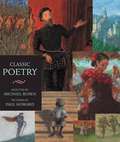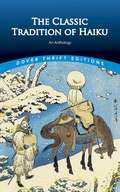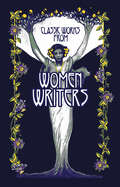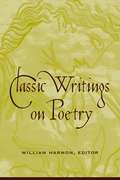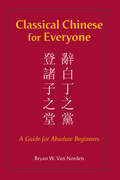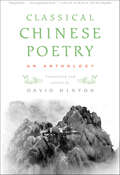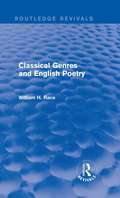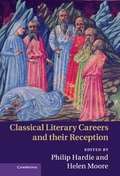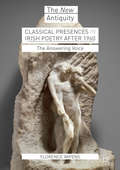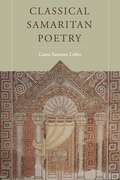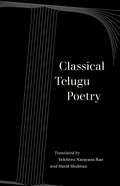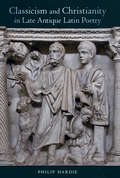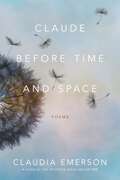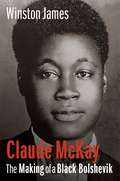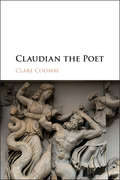- Table View
- List View
Classic Poetry: An illustrated collection
by Michael Rosen Paul HowardPoetry provides the best introduction to the marvels of the English language. This volume, collected by award-winning author Michael Rosen, presents a glorious selection of classic poetry, chronologically arranged from the seventeenth century to modern day—poems by such celebrated poets as William Shakespeare, Elizabeth Barrett Browning, Henry Wadsworth Longfellow, Emily Dickinson, Carl Sandburg, and Langston Hughes— complete with biographical sketches of the poets, information on individual poems, and notes on poetic forms. A book to be treasured, Classic Poetry belongs on every shelf—every child should know these poems and keep this book with them as they grow.
The Classic Tradition of Haiku: An Anthology (Dover Thrift Editions)
by Faubion BowersA highly distilled form of Japanese poetry, haiku consists of seventeen syllables, usually divided among three lines. Though brief, they tell a story or paint a vivid picture, leaving it to the reader to draw out the meanings and complete them in the mind's eye. Haiku often contains a hidden dualism (near and far, then and now, etc.) and has a seasonal tie-in, as well as specific word-images that reveal deeper layers in each poem.This unique collection spans over 400 years (1488-1902) of haiku history by the greatest masters: Bashō, Issa, Shiki, and many more, in translations by top-flight scholars in the field. Haiku commands enormous respect in Japan. Now readers of poetry in the West can savor these expressive masterpieces in this treasury compiled by noted writer Faubion Bowers, who provides a Foreword and many informative notes to the poems.
Classic Works from Women Writers (Leather-bound Classics)
by A. J. OdassoA fine collection of classic novels, short stories, poems, and essays from distinguished women writers. Women writers have been making their voices heard for centuries, but their works were not always taken seriously. Over time, as women gained more social and political freedom, these works have reemerged as subjects that are considered to be worthy of closer study. Classic Works from Women Writers is a collection of more than thirty novels, short stories, poems, and essays by prominent and lesser-known female writers since the seventeenth century. Included in this volume are groundbreaking works such as Mary Shelley&’s Frankenstein; Agatha Christie&’s The Mysterious Affair at Styles, the first Hercule Poirot novel; Charlotte Perkins Gilman&’s short story &“The Yellow Wallpaper&” and her follow-up essay; and poetry from the likes of Christina Rossetti, Amy Lowell, and Sara Teasdale. The words of these authors offer a multitude of perspectives on different issues that affect not only women but the wider world as well.
Classic Writings on Poetry
by William HarmonThe first major anthology of criticism devoted exclusively to poetry. Spanning thousands of years and including some of the most influential critical essays ever written, this is a collection of influential writings on poetry ranging from Aristotle to Laura (Riding) Jackson.
Classical Chinese for Everyone: A Guide for Absolute Beginners
by Bryan W. Van NordenIn just thirteen brief, accessible chapters, this engaging little book takes "absolute beginners" from the most basic questions about the language (e.g., what does a classical Chinese character look like?) to reading and understanding selections from classical Chinese philosophical texts and Tang dynasty poetry. "An outstanding introduction to reading classical Chinese. Van Norden does a wonderful job of clearly explaining the basics of classical Chinese, and he carefully takes the reader through beautifully chosen examples from the textual tradition. An invaluable work." —Michael Puett, Harvard University
Classical Chinese Poetry: An Anthology
by David Hinton“A magisterial book” of nearly five hundred poems from some of history’s greatest Chinese poets, translated and edited by a renowned poet and scholar (New Republic).The Chinese poetic tradition is the largest and longest continuous tradition in world literature. This rich and far-reaching anthology of nearly five hundred poems provides a comprehensive account of its first three millennia (1500 BCE to 1200 CE), the period during which virtually all its landmark developments took place. Unlike earlier anthologies of Chinese poetry, Hinton’s book focuses on a relatively small number of poets, providing selections that are large enough to re-create each as a fully realized and unique voice. New introductions to each poet’s work provide a readable history, told for the first time as a series of poetic innovations forged by a series of master poets.“David Hinton has . . . lured into English a new manner of hearing the great poets of that long glory of China’s classical age. His achievement is another echo of the original, and a gift to our language.” —W. S. Merwin
Classical Genres and English Poetry (Routledge Revivals)
by William H. RaceFirst published in 1988, this study explains how certain genres created by Classical poets were adapted and sometimes transformed by the poets of the modern world, beginning with the Tudor poets’ rediscovery of the Classical heritage. Most of the long-lived poetic genres are discussed, from familiar examples like the hymn, elegy and eulogy, to less familiar topics such as the recusatio (refusal to write certain kinds of poems), or formal structures such as priamel. By combining criticism with literary history, the author explores the degree to which certain poets were consciously imitating models, and demonstrates how various generic forms reflect the literary concerns of individual poets as well as the general concerns of their age. The poets discussed range over the whole of Graeco-Roman antiquity, and in English from Wyatt to Yeats and Auden. A detailed and fascinating title, this study will appeal to teachers and students of both English and Classical literature.
Classical Literary Careers and Their Reception
by Philip Hardie Helen MooreThis is a wide-ranging collection of essays on ancient Roman literary careers and their reception in later European literature, with contributions by leading experts. Starting from the three major Roman models for constructing a literary career - Virgil (the rota Vergiliana), Horace and Ovid - the volume then looks at alternative and counter-models in antiquity: Propertius, Juvenal, Cicero and Pliny. A range of post-antique responses to the ancient patterns is examined, from Dante to Wordsworth, and including Petrarch, Shakespeare, Milton, Marvell, Dryden and Goethe. These chapters pose the question of the continuing relevance of ancient career models as ideas of authorship change over the centuries, leading to varying engagements and disengagements with classical literary careers. The volume also considers other ways of concluding or extending a literary career, such as bookburning and figurative metempsychosis.
Classical Presences in Irish Poetry after 1960: The Answering Voice (The New Antiquity)
by Florence ImpensThis book provides the first overview of classical presences in Anglophone Irish poetry after 1960. Featuring detailed studies of Seamus Heaney, Michael Longley, Derek Mahon, and Eavan Boland, including close readings of key poems, it highlights the evolution of Irish poetic engagements with Greece and Rome in the last sixty years. It outlines the contours of a 'movement' which has transformed Irish poetry and accompanied its transition from a postcolonial to a transnational model, from sporadic borrowings of images and myths in the poets' early attempts to define their own voices, to the multiplication of classical adaptations since the late 1980s -- at first at a time of personal and political crises, notably in Northern Ireland, and more recently, as manifestations of the poets' engagements with European and other foreign literatures.
Classical Samaritan Poetry
by Laura Suzanne LieberThis book introduces the evocative but largely unknown tradition of Samaritan religious poetry from late antiquity to a new audience. These verses provide a unique window into the Samaritan religious world during a formative period.Prepared by Laura Suzanne Lieber, this anthology presents annotated English translations of fifty-five Classical Samaritan poems. Lieber introduces each piece, placing it in context with Samaritan religious tradition, the geopolitical turmoil of Palestine in the fourth century CE, and the literary, liturgical, and performative conventions of the Eastern and Western Roman Empires, shared by Jews, Christians, and polytheists. These hymns, composed by three generations of poets—the priest Amram Dara; his son, Marqah; and Marqah’s son, Ninna, the last poet to write in Samaritan Aramaic in the period prior to the Muslim conquest—for recitation during the Samaritan Sabbath and festival liturgies remain a core element of Samaritan religious ritual to the present day.Shedding important new light on the Samaritans’ history and on the complicated connections between early Judaism, Christianity, the Samaritan community, and nascent Islam, this volume makes an important contribution to the reception of the history of the Hebrew Bible. It will appeal to a wide audience of students and scholars of the Hebrew Bible, the New Testament, early Judaism and early Christianity, and other religions of late antiquity.
Classical Samaritan Poetry
by Laura Suzanne LieberThis book introduces the evocative but largely unknown tradition of Samaritan religious poetry from late antiquity to a new audience. These verses provide a unique window into the Samaritan religious world during a formative period.Prepared by Laura Suzanne Lieber, this anthology presents annotated English translations of fifty-five Classical Samaritan poems. Lieber introduces each piece, placing it in context with Samaritan religious tradition, the geopolitical turmoil of Palestine in the fourth century CE, and the literary, liturgical, and performative conventions of the Eastern and Western Roman Empires, shared by Jews, Christians, and polytheists. These hymns, composed by three generations of poets—the priest Amram Dara; his son, Marqah; and Marqah’s son, Ninna, the last poet to write in Samaritan Aramaic in the period prior to the Muslim conquest—for recitation during the Samaritan Sabbath and festival liturgies remain a core element of Samaritan religious ritual to the present day.Shedding important new light on the Samaritans’ history and on the complicated connections between early Judaism, Christianity, the Samaritan community, and nascent Islam, this volume makes an important contribution to the reception of the history of the Hebrew Bible. It will appeal to a wide audience of students and scholars of the Hebrew Bible, the New Testament, early Judaism and early Christianity, and other religions of late antiquity.
Classical Telugu Poetry: An Anthology (Voices from Asia #13)
by Velcheru Narayana Rao David ShulmanThe classical tradition in Telugu, the mellifluous language of Andhra Pradesh in southern India, is one of the richest yet least explored of all South Asian literatures. In this volume, Velcheru Narayana Rao and David Shulman have brought together mythological, religious, and secular texts by twenty major poets who wrote between the eleventh and nineteenth centuries, providing an authoritative volume overview of one of the world's most creative poetic traditions. An informative, engaging introduction fleshes out the history of Telugu literature, situating its poets in relation to significant literary themes and historical developments and discussing the relationship between Telugu and the classical literature and poetry of Sanskrit.
Classicism and Christianity in Late Antique Latin Poetry (Sather Classical Lectures #74)
by Prof. Philip HardieAfter centuries of near silence, Latin poetry underwent a renaissance in the late fourth and fifth centuries CE evidenced in the works of key figures such as Ausonius, Claudian, Prudentius, and Paulinus of Nola. This period of resurgence marked a milestone in the reception of the classics of late Republican and early imperial poetry. In Classicism and Christianity in Late Antique Latin Poetry, Philip Hardie explores the ways in which poets writing on non-Christian and Christian subjects used the classical traditions of Latin poetry to construct their relationship with Rome’s imperial past and present, and with the by now not-so-new belief system of the state religion, Christianity. The book pays particular attention to the themes of concord and discord, the "cosmic sense" of late antiquity, novelty and renouatio, paradox and miracle, and allegory. It is also a contribution to the ongoing discussion of whether there is an identifiably late antique poetics and a late antique practice of intertextuality. Not since Michael Robert's classic The Jeweled Style has a single book had so much to teach about the enduring power of Latin poetry in late antiquity.
Classics for Young Readers, Volume 3B
by John HoldrenClassics for Young Readers, Volume 3B contains Lessons Learned, Folk Tales of Many Lands, Norse Myths, Tales of Hans Christian Andersen, Poetry At Odds, and For the Fun of It.
Classics for Young Readers, Volume 4A
by John HoldrenLessons learned: Child's play; Chanticleer and the fox; The bear boy; The king and his hawk; It could always be worse; The green glass ball -- Trickster tales: How bear lost his tail; From tiger to anansi; Brer Rabbit gets Brer Fox's dinner; Brer Rabbit goes back to Mr. Man's garden -- Stories from the Bible: Noah and the ark: Joseph and his brothers; The story of Moses -- Life stories: Louis Pasteur, battle with death; Elizabeth Blackwell, a pioneering physician; Sir Alexander Fleming, the accident that changed the world -- A patchwork of people: Some people; Thoughts on talkers; Ten kinds; Going too far; Eat-it-all Elaine; Jimmy Jet and his TV set; Jonathan Bing; The Pirate Don Durk of Dowdee; Rhinos purple, hippos green; Since Hanna moved away; Pete at the zoo -- Stories in verse: Daddy fell into the pond; Millions of strawberries; The elf and the dormouse; The leak in the dike; Adventures of Isabel; Mummy slept late and Daddy fixed breakfast; Hiawatha's childhood.
Classics for Young Readers, Volume 4B
by John HoldrenThe collection includes: Stories from Many Lands, King Arthur and the Knights of the Round Table, Life stories to Fly By, Poetry sounds and sensations, and What's the metaphor for?
Classics for Young Readers, Volume 5A
by John HoldrenChildren will love to read this collection of delightful stories and poems. The collection includes lessons learned from stories such as The Fire on the Mountain and Salt and Bread, Heroic legends such as Robin Hood and Mulan, famous stories such as The Prince and the Pauper, and Bible stories such as the story of David. Poetry selections in this volume focus on Seasons and Passing Moments.
Classics for Young Readers, Volume 5B
by John HoldrenChildren will love to read this collection of delightful stories and poems. The collection includes stories from Shakespeare such as The Tempest, adventure stories from Sherlock Holmes, excerpts from Little Women, as well as life stories of the young and brave such as Frederick Douglass. Poetry selections in this volume focus on Transportation and American Themes.
Classics for Young Readers, Volume 7
by John Holdren Scott BrooksA great collection of stories for children which include popular classics like Rumpelstiltskin.
Claude before Time and Space: Poems (Southern Messenger Poets)
by Claudia EmersonIn Claude before Time and Space, her final collection, Pulitzer Prize–winning poet Claudia Emerson quietly but fiercely explores the themes of mortality and time. <P><P>In the first section of this book, “The Wheel,” Emerson uses a rural southern setting in poems that reflect on memory, the self, and relationships. In section two, “Bird Ephemera,” she explores historical figures—from an early naturalist and writer who raised her children in poverty to a small-town doctor. The collection concludes with a series of poems named after the poet’s father. This illuminating body of work displays a master poet at the height of her craft.
Claude McKay: The Making of a Black Bolshevik
by Winston JamesOne of the foremost Black writers and intellectuals of his era, Claude McKay (1889–1948) was a central figure in Caribbean literature, the Harlem Renaissance, and the Black radical tradition. McKay’s life and writing were defined by his class consciousness and anticolonialism, shaped by his experiences growing up in colonial Jamaica as well as his early career as a writer in Harlem and then London. Dedicated to confronting both racism and capitalist exploitation, he was a critical observer of the Black condition throughout the African diaspora and became a committed Bolshevik.Winston James offers a revelatory account of McKay’s political and intellectual trajectory from his upbringing in Jamaica through the early years of his literary career and radical activism. In 1912, McKay left Jamaica to study in the United States, never to return. James follows McKay’s time at the Tuskegee Institute and Kansas State University, as he discovered the harshness of American racism, and his move to Harlem, where he encountered the ferment of Black cultural and political movements and figures such as Hubert Harrison and Marcus Garvey. McKay left New York for London, where his commitment to revolutionary socialism deepened, culminating in his transformation from Fabian socialist to Bolshevik.Drawing on a wide variety of sources, James offers a rich and detailed chronicle of McKay’s life, political evolution, and the historical, political, and intellectual contexts that shaped him.
Claudian and the Roman Epic Tradition
by Catherine WareThe historical importance of Claudian as writer of panegyric and propaganda for the court of Honorius is well established but his poetry has been comparatively neglected: only recently has his work been the subject of modern literary criticism. Taking as its starting point Claudian's claim to be the heir to Virgil, this book examines his poetry as part of the Roman epic tradition. Discussing first what we understand by epic and its relevance for late antiquity, Catherine Ware argues that, like Virgil and later Roman epic poets, Claudian analyses his contemporary world in terms of classical epic. Engaging intertextually with his literary predecessors, Claudian updates concepts such as furor and concordia, redefining Romanitas to exclude the increasingly hostile east, depicting enemies of the west as new Giants and showing how the government of Honorius and his chief minister, Stilicho, have brought about a true golden age for the west.
Claudian the Poet
by Clare CoombeThis comprehensive reassessment of the carmina maiora of the fourth-century poet Claudian contributes to the growing trend to recognize that late antique poets should be approached as just that: poets. Its methodology is developed from that of Michael Roberts’ seminal The Jeweled Style. It analyses his poetics and use of story-telling to argue that the creation of a story-world in which Stilicho, his patron, becomes an epic hero and the barbarians are giants threatening both the borders of Rome and the order of the very universe is designed to convince his audience of a world-view in which it is only the Roman general who stands between them and cosmic chaos. The book also argues that Claudian uses the same techniques to promote the message that Honorius, young hero though he may seem, is not yet fit to rule, and that Stilicho's rightful position remains as his regent.
Cleaned the Crocodile's Teeth
by Terese SvobodaThe Nuer are a cattle herding people who live along the Nile. Although only a half million in population, they were made world famous by anthropologist E. Evans Pritchard's classic "The Nuer." Song is the art form most suited to their harsh climate and semi-nomadic existence. Cleaned the Crocodile's Teeth was translated by Terese Svoboda, who collected and transcribed them in the Sudan with the aid of a PEN/Columbia Fellowship. The National Endowment for the Humanities provided support for the completion of the project. However, Cleaned the Crocodile's Teeth is more than just the translation of these songs. Its linking narrative, which chronicles Svoboda's experiences and places the songs in their proper contexts, takes us along on the translator's sometimes difficult journey and gives us an even deeper glimpse into the often hard, but never hopeless lives of the Nuer.
